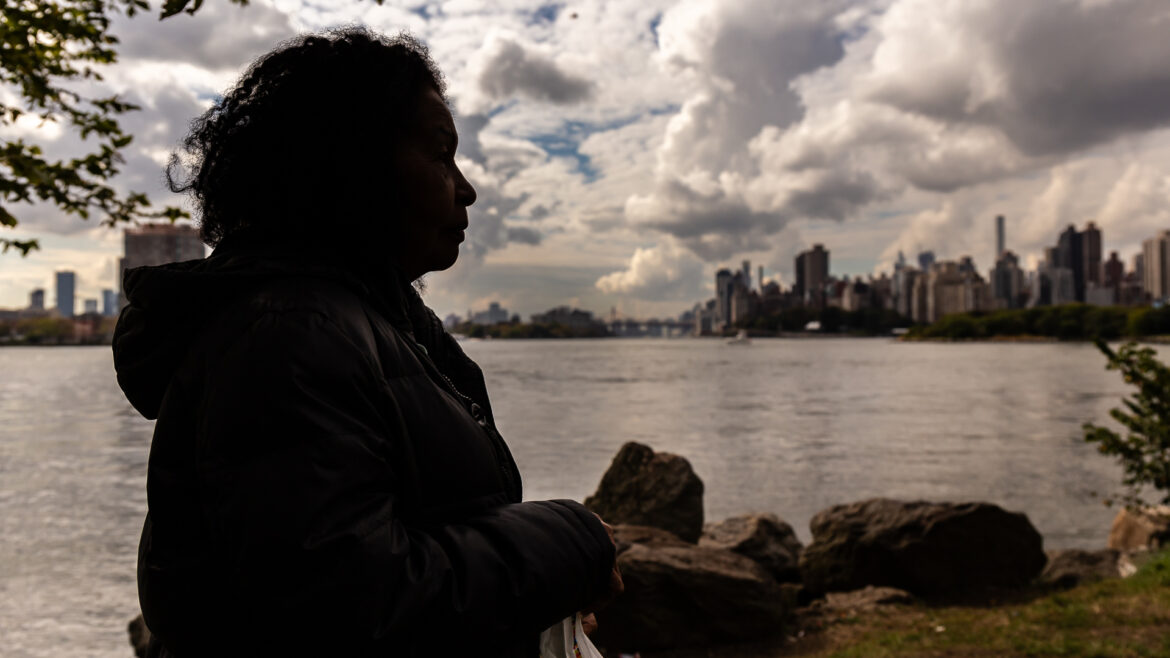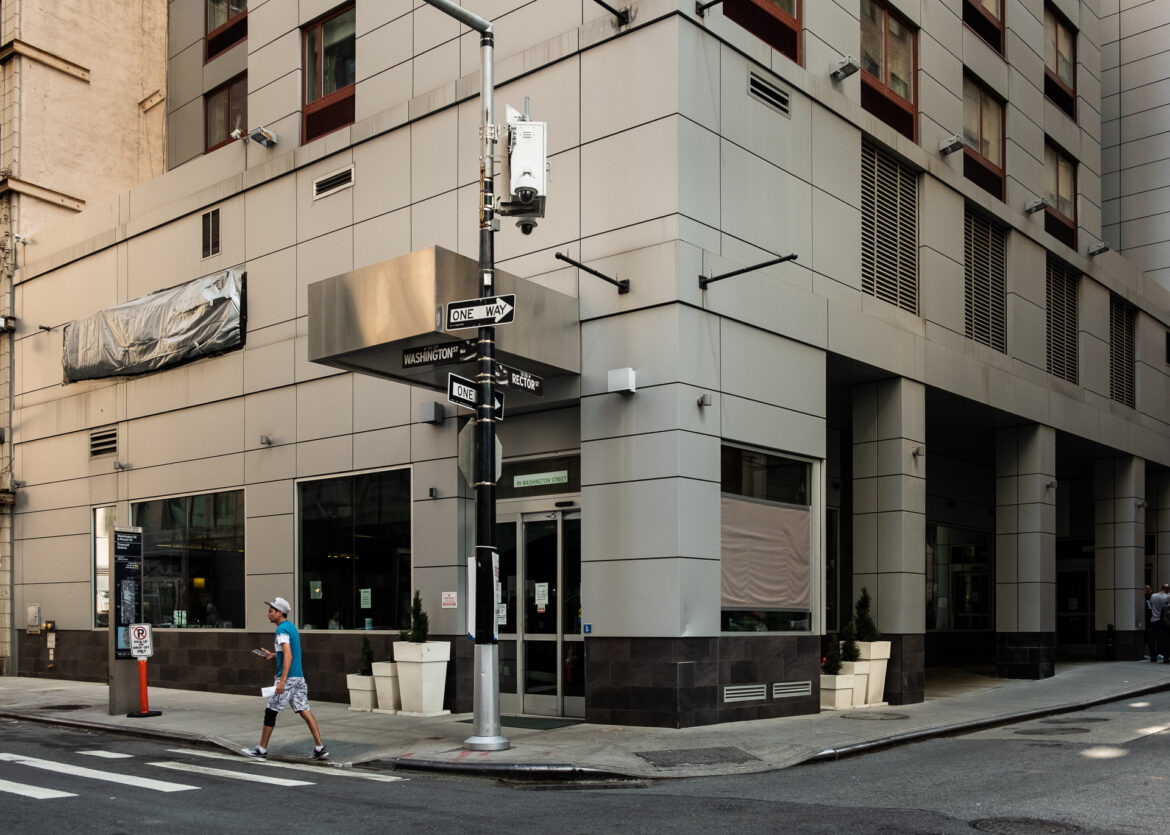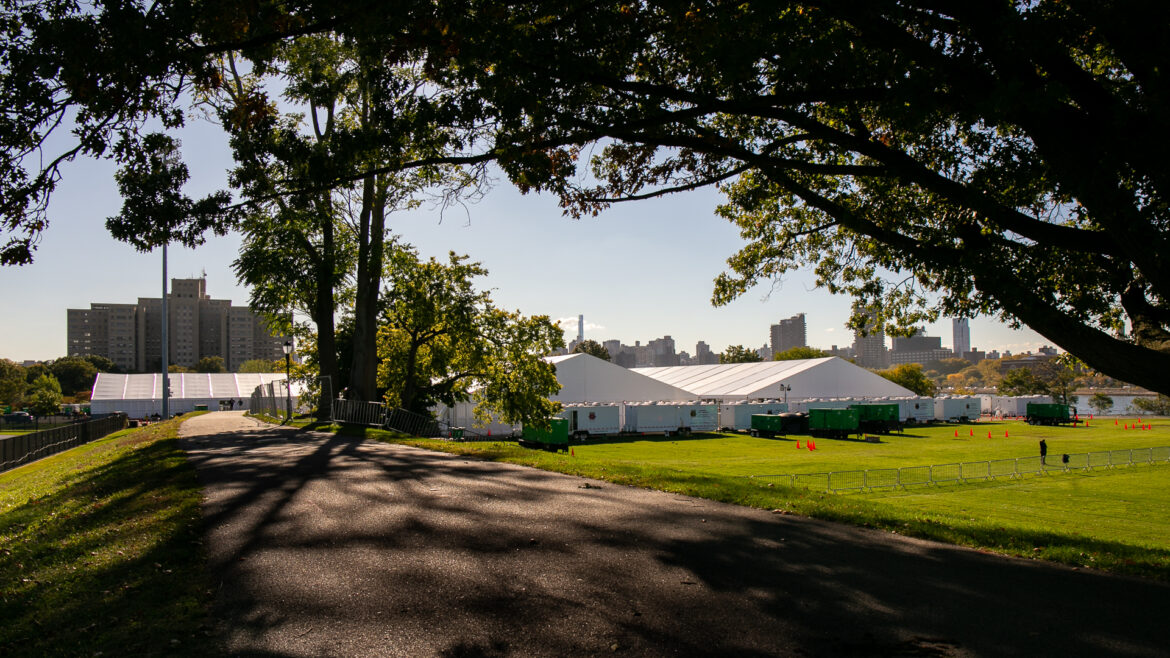“It looks like a coughing choir in that tent,” said Luis Zambrano, 62, who came down with pneumonia this winter while staying at the shelter complex on Randall’s Island, where the city has been housing thousands of newly arrived immigrants. “The cold that passes through and under the cot doesn’t go away with several blankets, so you are always cold sleeping.”

Adi Talwar
Carolina, 70, on Randall’s Island in October. Cots at the tent shelter where she was staying are low to the ground, making getting in and out of bed painful, she said.Lea la versión en español aquí.
Luis Zambrano, 62, caught a cold in the early days of November. After a month, it had turned into a persistent cough that wouldn’t go away. And he wasn’t the only one.
“It looks like a coughing choir in that tent,” Zambrano said in Spanish, referring to the shelter tent complex on Randall’s Island where he was staying and where the city has been housing thousands of newly arrived immigrants since August, sleeping head-to-toe on thin cots. “The cold that passes through and under the cot doesn’t go away with several blankets, so you are always cold sleeping.”
Zambrano and others staying at the Humanitarian Emergency Response and Relief Center (HERRC) on Randall’s Island told City Limits they’ve been seeing and hearing the telltale signs of cold and flu season: more coughing and nose-blowing in recent months at the site.
City Hall and NYC Health + Hospitals (H+H) —the public-private entity that oversees the Randall’s Island HERRC—referred questions about the number of COVID-19, flu and cold cases there this winter to the city’s Department of Health, but the agency did not respond to City Limits’ inquiries.
On Dec. 20, Zambrano said he went to the hospital, where was diagnosed with pneumonia and advised to rest and take medication to reduce inflammation in his bronchial tubes.
He was one of six people transferred from Randall’s Island to isolate at the Holiday Inn in lower Manhattan in November and December, according to the city’s Health + Hospitals. Shelter residents diagnosed with infectious diseases such as COVID-19, varicella, scabies, and hand, foot, and mouth disease have been moved to rooms at the hotel, which is also being used by the city as a HERRC to shelter immigrant families with children.
Another 12 people were sent to the hotel after medical evaluation during intake at the city’s main arrival center at the Roosevelt Hotel, where immigrants seeking shelter for the first time are offered vaccinations and screened for COVID-19, varicella, scabies, and active Tuberculosis. Since the facility opened in May 2023, Arrival Center staff have provided medical screenings to more than 100,000 asylum seekers, out of the 168,000 immigrants who’ve arrived since the spring of 2022, according to officials.
H+H said Randall’s has COVID-19 tests on-site for migrants who want to self-test. Those seeking medical assistance can call a telemedicine hotline with interpreters available, or be connected to providers, local H+H facilities, or Federal Qualified Health Centers—nonprofit clinics that serve underserved populations.

Adi Talwar
A hotel in lower Manhattan that has been used as a shelter for the last several months.
Zambrano spent three days at the Holiday Inn, where he said he didn’t have the strength to leave his room, walking only from his bed to the door to pick up the food that was left for him. He saved his energy to talk during the two check-ups a day that he was given, he said.
H+H said patients at the hotel are placed in rooms on designated floors with 24/7 security to ensure proper isolation protocols. Everyone is required to wear masks and PPE, and to use a service elevator separate from the one used by others in the building. Those with COVID-19 infections are isolated for five days following the CDC’s guidance, according to H+H.
Zambrano said his pneumonia earned him just three days at the hotel, and that he still wasn’t fully recovered when his time was up. He returned to the Randall’s Island shelter, where he asked to be transferred back to the Holiday Inn. “I coughed in front of the staff so they would hear me and see that I still had plenty of chest phlegm,” he explained.
But his bid for a new hotel placement was turned down. As a last resort, he said he filed a formal Reasonable Accommodation Request, through which shelter residents with disabilities can seek changes to the services they’re receiving. This too was unsuccessful, he said.
His time at Randall’s came to an end early this month, after his 30-day shelter deadline—part of a controversial city policy aimed at freeing up space in the overwhelmed system—expired.
For 10 days he was in limbo, going to the city-run “reticketing center” in the East Village, where hundreds of migrants have been lining up in the cold each day to apply for a ticket out of town or a new shelter placement. After waiting in line during the day, he slept on the floor of churches being used by the city as “waiting areas” for those with no other options.
Since Jan. 22, Zambrano has been staying in a congregate “respite center” for immigrants that the city has set up in an old Judo gym in Astoria.
“That was part of what we went through, and it wasn’t easy,” he said of the process of reapplying for a bed. “Waiting outside a church from 6 p.m. to 9 p.m. in this devastating cold, imagine—freezing in line because they only took 28 people, but you don’t have the right to take a bath, waking up at 5:30 a.m. to be outside at 6 a.m.”
Beyond temporary illnesses, the city’s tent shelters pose hurdles for those with chronic health conditions as well as for the aging, according to several who spoke with City Limits about their experiences.

Adi Talwar
The city’s Humanitarian Emergency Response and Relief Center (HERRC) on Randall’s Island, where immigrants sleep on lined up cots, pictured here in October.
Sandra Bedoya takes medications for multiple ailments—coronary artery disease, hypertension, mitral valve prolapse, fatty liver disease, abnormal thyroid level, disc height loss, marginal sclerosis, and chronic left-sided back pain—so she has to use the bathroom frequently.
Bathrooms at the HERRCs on Randall’s Island, where Bedoya was staying from October to December, are located outside the facility’s sleeping tents. Though the bathroom was only a few feet from her tent, she had trouble making it in time. At 53, she began wearing a diaper at night when she didn’t have to before.
She had arrived in New York City in May and went through several shelters, including the respite center at St. Margaret Mary’s Catholic Church in Astoria and the Holiday Inn Manhattan downtown that housed couples—as in her case—and single adults for several months and then became a HERRC for families with children.
She said she talked with a social worker at Randall’s about being moved to a more private accommodation, somewhere with easier access to a bathroom. She spent months undergoing tests and asking for letters to support a transfer.
“This accommodation can be either a single room or a shelter hotel,” states the Nov. 14 letter from her health care provider, Elmhurst Hospital Clinic, supporting Bedoya’s case. “Her comorbidities puts her at increased risk of severe illness from potentially infected or healthier individuals, and vice versa,” explains the letter, adding that her relocation is advisable to prevent further complications.
But she said her requests were denied, and that such transfers were reserved for the most serious cases. “Only a case of life or death: when I‘m dying, practically,” Bedoya said in Spanish.
When asked what medical conditions or circumstances warrant transfers, or how many such transfer requests have been granted, the NYC Health + Hospitals did not give a clear answer, but pointed to on-site health care resources available to those staying at its HERRCs, including a telehealth program to connect them with providers.
Upon entering shelter, HERRC residents are screened for disabilities to determine an appropriate placement, according to City Hall, and they can also request reasonable accommodations at any time.*
Josh Goldfein, an attorney for the Legal Aid Society—one of the organizations currently defending the city’s right to shelter in court—said requests like Bedoya’s are usually considered by agencies on a “case by case inquiry.”
“[It] would depend on the particular facts of that individual’s situation,” Goldfein said. “The person could be accommodated on site or through a transfer depending on what the agency has to offer.”
The city recently granted an exemption to its 30- and 60-day shelter deadlines for pregnant immigrants in their third trimester or those with newborn babies, according to recent reporting from the news site The City.
On the other end of the age spectrum, city officials say there were 110 immigrants in the shelter system 65 and older as of Jan. 7—a fraction of the more than 68,000 currently in the city’s care. They include Carolina, who traveled from Venezuela with her son’s family and stayed at the Randall’s Island HERCC from September to November.
Cots at the tent shelter are low to the ground, just over a foot high. At Carolina’s age of 70, just waking up and getting out of bed, or bending over to lie down, is painful, she said.
Despite arriving in the city more than four months ago, Carolina told a reporter in October, she hadn’t found steady work. To earn some money, she started selling lollipops outside and inside Randall’s tents.
“That won’t make me rich, but it helps me,” she added.
To reach the reporter behind this story, contact Daniel@citylimits.org. To reach the editor, contact Jeanmarie@citylimits.org
*This story has been updated since original publication to include additional details about the city’s health screening process at shelter intake.








